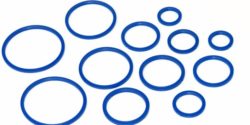Viton™ O Rings vs Nitrile O Rings
Comparison of two of the most commonly used elastomers – Viton™ O Rings vs Nitrile O Rings
As two of the most widely used elastomers, Viton™ (FKM/FPM) and Nitrile (NBR) have some great properties. Both provide a supreme compression set and have an extensive range of purposes in both domestic and industrial installations. Nevertheless, they’re not totally equal in their properties and it’s essential to take under consideration which is better for your specific application. Below, you can find information about Viton™ O Rings vs Nitrile O Rings:
Viton™ (FKM/FPM)
Viton™ is a trademark of The Chemours Company FC and refers to Fluorocarbon (FKM/FPM) O Rings. Numerous types of FKM/FPM/Viton™ O Rings are available with different fluorine levels which enhances performance in specific applications.
General temperature range
Between -40°C and +250°C
Shore A hardness
Between 50 and 95 Shore A
Industries
Virtually all industries, including Aerospace & Defence, Agriculture, Automotive, Energy, Food & Drink, Industrial, Offshore Drilling, Petrochemical, Rail, Semiconductor.
Key uses
- In a huge variety of applications – from aircraft engines to vehicle components (especially where resistance to corrosive fuels and liquids is a must)
- Automotive fuel handling
- In various mechanical devices that require maximum resistance to high temperatures
- General industrial seals and gaskets
- In applications where high resistance is needed to chemical attacks and high temperature
- Food applications
Resistance
- Resistant to the majority of chemicals
- Resistant to mineral acids and halogenated hydrocarbons
- Excellent tolerance for high temperatures
- Resistant to oils, fuels, hydraulic fluids, and hydrocarbons as well as aromatics and solvents
- Resistant to degradation by UV, weather, ozone and mould
- Resistance to gasoline, alcohol, acids, water, oils, oxidation, ageing, radiation, heat and water
Key features
- Very low gas permeability
- Excellent for vacuum applications
- Self-extinguishing
- Dynamic
- Low compression set
- Tensile strength
- The superior swell in high octane and oxygenated fuels
Available specifications
- Food & Pharma: FDA, EC1935/2004 & EC2023/2006 European Regulations, 3A 18-03 Sanitary standards, BGW, USP Class VI
- Water: WRc, WRAS, DVGW, KTW, ACS, NSF 61, W270
- Oil & Gas: NORSOK M-710, NACE, TOTAL GS PVV 142/03, DIN EN 549
- Aerospace & Defence: Defence Standard 02/337, MIL-Spec, ASTM D-2000 (SAE J200)
- Other: UL, DIN EN 14241-1, MIL-R-83248
Limitations
- Less tolerant of low temperatures
- Poor low-temperature flexibility
- Not recommended for ketones, amines, hot water, steam, polar solvents
Nitrile (NBR)
Nitrile (NBR) is also called Buna-N. O Rings made out of Nitrile are probably the most affordable and most commonly used elastomer seals.
General temperature range
Between -40°C and +135°C
Shore A hardness
Between 40 and 90 Shore A
Industries
Virtually all industries, including Aerospace & Defence, Agriculture, Automotive, Biotechnology, Bus Truck & Trailer, Food & Drink, Marine, Pharmaceutical, Pump & Gas, Water
Key uses
- General purpose, especially in applications where the seal will be exposed to hydrocarbons, oils, petrol, water and hydraulic fluids
- Marine, Automotive and Aircraft fuel structures
- Off-road equipment
- Oil resistant applications of all sorts
- Low-temperature military uses
- Hygienic applications
- Food applications
Resistance
- Superb resistance to petroleum-based oils and fuels
- Excellent resistance to hydraulic fluids, water, alcohol and silicone greases
- Excellent resistance to oil, air, alcohols, diluted acids, gasoline, hydraulic fluids, vegetable oil, motor oil, mineral oil, water, hydraulic fluids, engine coolants, alkalines, diluted acids
Key features
- Excellent abrasion and tear resistance
- Great tensile strength
- Compression set resistance
- Good impermeability
- Heat resistance
- Cold resistance
- Cost-effective (very economical)
Available specifications
- Food & Pharma: FDA, EC1935/2004 & EC2023/2006 European Regulation, 3A 18-03 Sanitary Standards
- Water: WRc, WRAS, ACS, KTW, NSF 61, W270, DVGW
- Aerospace & Defence and Military: MIL-Spec,
- Oil & Gas: DIN EN 549
Limitations
- Not good at resisting degradation by ozone or weather
- Not recommended for brake fluids and acetones

Viton™ O Rings vs Nitrile O Rings – Which is the right choice?
Looking at these two materials, it’s quite easy to notice some advantages of Viton™, which would make it a favourite when making choice vs Nitrile (NBR). For instance, if your installation requires the material to perform at constant high temperatures of 100°C and more, Nitrile (NBR) will not be suitable. A similar situation will occur when your application is exposed to UV, ozone and/or weather, then Nitrile (NBR) will degrade and most likely fail.
It is easy to notice that Viton™ (FKM/FPM) is a better material in most situations, excluding at sub-zero temperatures, in which Nitrile (NBR) turns out to be a much better performer.
Our experienced team will guide all aspects of production, including prototyping, testing, and final part manufacture. Depending on the application M Barnwell Services and it’s manufacturing partners offer full batch traceability throughout the manufacturing process and the issuing of BS EN ISO 10204 certification when available. If you require further information regarding Viton™ and Nitrile O Rings please contact a member of the team.
E & OE. M Barnwell Services endeavour to make sure that all content is correct. We have gathered this information from manufacturing partners. (Viton™ is a trademark of The Chemours Company FC, LLC. M Barnwell Services does not manufacture Viton™ products)